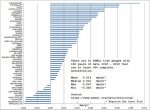This is a really interesting video, but the primary problem with this type of analysis compared to using projections is the fact that sea level rise depends to some extent upon the occurrence of major events that become more likely over time. For example, if the Greenland ice sheet were to completely melt, something that scientists predict would likely occur after a
2-3 degree rise in global temperature, then the global sea rise would be around
seven meters or 24 feet.
The analysis from your video does accurately note that most of the CO2 was added to the atmosphere after 1950, but it fails to mention that CO2 has a roughly
40 year lag between the addition of the CO2 and it's impact on global temperatures. As such, CO2 added in 1950 would only be represented by global temperature increases (and thus the impact on the global sea levels through melting ice and thermal expansion) by 1990. And the CO2 production, 75% of which was added after 1950, was not added in a uniform rate, but at an accelerating rate where each year saw more CO2 being added versus the previous year. And so, we should expect to see an acceleration in the global temperature (and
we are) and an acceleration in the global sea levels.
And guess what?
We are.


